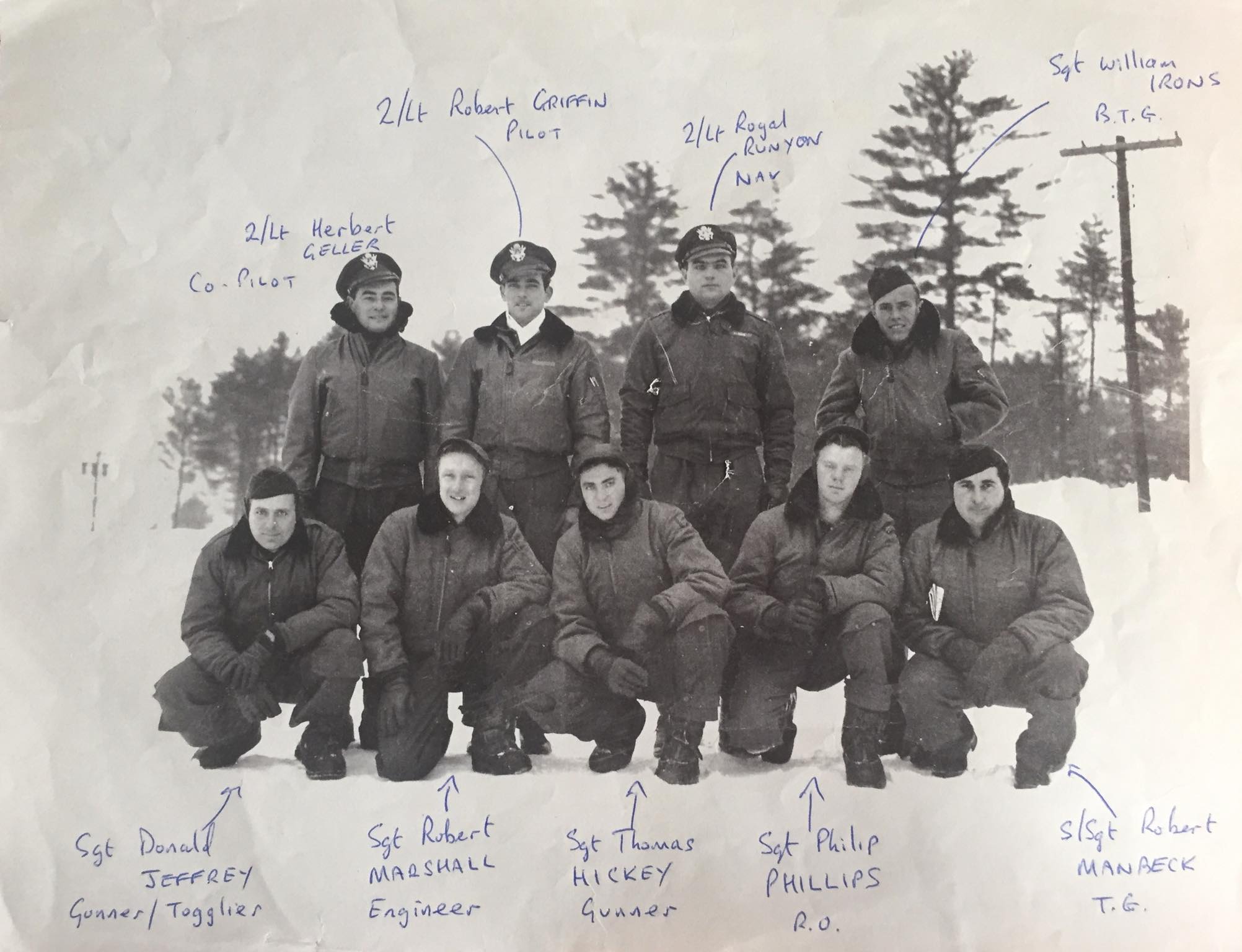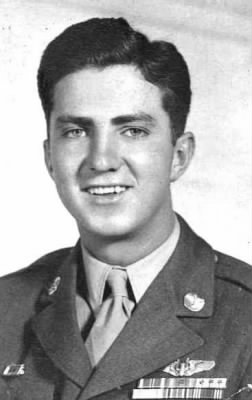
Robert S. Griffin Crew, all killed in action on 19th March 1945 after their aircraft crashed on a hill side near Reigate, UK. Photo courtesy of www.384thbombgroup.com

S/Sgt. Thomas James Hickey Jnr. Photo courtesy of www.384thbombgroup.com
The Story of Thomas James Hickey Jnr.
Last updated: June 28, 2025, 8:48 amS/Sgt.
Thomas J. Hickey Jnr.
Flexible Gunner
547th Bomb Squadron
384th Bombardment Group (Heavy)
Serial Nr 12032033
In the course of his duties, Thomas Jr. was awarded the Purple Heart medal, Air Medal with 3 Oak Leaf Clusters, and the Distinguished Flying Cross (on two occasions according to his obituary).
Thomas James Hickey Jr. was born in Limerick, Ireland in 1923. His father, also Thomas James Hickey (born 31st March 1895?), had served for the British Army during World War 1. His mother was Kathleen Elizabeth O’Connor (born 9th June 1897). They had four children – Joseph, Thomas Jr., James and Mary.
On the 8th July 1923 records show Kathleen (now Kathleen Hickey) arriving in New York via sea passage from Cobh, Ireland – she was 25 years old and had with her Joseph(aged 5 year) and Thomas (aged 10 months). It would appear her husband, Thomas J. Hickey Sr., was already in New York at this time. They were to settle as a family in Brooklyn, New York.
An obituary from The Brooklyn Daily Eagle (17th May 1945) details that Thomas Jr. had attended James Madison High School in Brooklyn, before entering military service on 24th July 1941, in New York.
His early military career isn’t detailed, however from the obituary we can learn that before his move to the European Theatre of war, he was already a veteran of 59 missions in the South Pacific, in the battle against Japan.
On the 2nd February 1945, Thomas Jr. had arrived in England and had been assigned to the 547th Bomb Squadron, 384th Bombardment Group (H) based at Station 106 RAF Grafton Underwood, Northamptonshire, England. The unit flew four engine heavy bombers – Boeing B-17 Flying Fortresses - in the European Theatre of War. He was listed as a Sergeant initially, later a Staff Sergeant, and was a flexible gunner on the crew. His first mission came on the 19th February 1945, and records show that he was temporarily admitted to a military hospital in March 1945 for concussion and burns as a result of an aircraft crash. It is unclear how this had happened.
By 19th March 1945, Thomas Jr. had completed 13 missions with the 384th BG, his 14th was as part of the crew piloted by 2Lt. Robert S. Griffin to the synthetic oil plant at Bohlen, Germany. They were to fly in B-17G #43-39035 SO*F – this was to be the aircrafts 20th Mission since its arrival on the 1st January 1945. For the 384th Bombardment Group this was mission number 292, and for the 8th Air Force it was mission number 896.
Between 08.26am and 08.58am, the 384th despatched 50 aircraft for the mission. They were part of the 1st Air Division, which for this mission comprised a total of 436 B17’s and 153 P51 Mustang escort fighters. At 13.45pm they group encountered 3 German jet fighters, but with a good escort of fighters these were driven away. As they neared the target dense cloud cover and contrails conspired to make the initial target unsuitable for bombing, so the alternative target of the Vomag Maschinen Fabrik oil refinery at Plauen, Germany was selected as the target for the mission. The bomb run was completed at 25,000ft with 5/10’s cloud, results were deemed as ‘fair’, and the group turned for home.
Unfortunately on their return to England, the weather had deteriorated greatly. Some crews ran short of fuel and had to land at alternate fields, whilst others searched for airfields that had favourable conditions for landing.
It is assumed that whilst searching for a suitable landing filed, the aircraft flew into the chalk ridge on the high ground at Colley Hill, Reigate, Surrey, England, just south of London which was possibly obscured by low cloud. The force of the impact completely destroyed the B17, with the immediate loss of all crew members, including S/Sgt Thomas J. Hickey Jr.
Today, a memorial stands on the hill at the site of the crash, which was dedicated on the 19th March, 2001. Two wooden wing tips show the location of the crash, and are exactly to size of the wingspan of a B17. Inside these wooden ‘tips’ are molten aluminium remnants of B-17G #43-39035.
Thomas Jr.’s remains were eventually interred in the Cambridge American Cemetery at Coton, Cambridgeshire, England. The remains of three other crewmen from the aircraft on this fateful mission are also interred here – Togglier Sgt. Donald W. Jeffrey, Engineer Sgt. Robert F. Marshall and Navigator 2Lt. Royal A. Runyon.
The Wings Museum based in West Sussex have researched the crash, and have some excellent information contained in an article – please see link below.
https://www.wingsmuseum.co.uk/our-work/aircrew-memorials/b-17g-tail-number-43-39035/
Research courtesy of Keith Andrews on behalf of 384th Bombardment Group Museum.
With kind thanks to the 384th Bomb Group website (384thbombgroup.com) for permission in using material from their records in the making of this story. It holds a wealth of information, documents and photographs of their activities during World War 2.
Gallery

Robert S. Griffin Crew, all killed in action on 19th March 1945 after their aircraft crashed on a hill side near Reigate, UK. Photo courtesy of www.384thbombgroup.com

S/Sgt. Thomas James Hickey Jnr. Photo courtesy of www.384thbombgroup.com